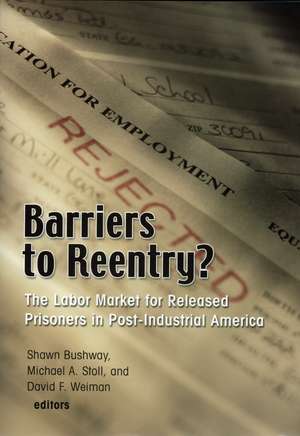Barriers to Reentry?: The Labor Market for Released Prisoners in Post-Industrial America
Editat de Shawn D. Bushway, Michael A. Stoll, David Weimanen Limba Engleză Hardback – 13 iun 2007
With the introduction of more aggressive policing, prosecution, and sentencing since the late 1970s, the number of Americans in prison has increased dramatically. While many have credited these "get tough" policies with lowering violent crime rates, we are only just beginning to understand the broader costs of mass incarceration. In Barriers to Reentry? experts on labor markets and the criminal justice system investigate how imprisonment affects ex-offenders' employment prospects, and how the challenge of finding work after prison affects the likelihood that they will break the law again and return to prison. The authors examine the intersection of imprisonment and employment from many vantage points, including employer surveys, interviews with former prisoners, and state data on prison employment programs and post-incarceration employment rates. Ex-prisoners face many obstacles to re-entering the job market—from employers' fears of negligent hiring lawsuits to the lost opportunities for acquiring work experience while incarcerated. In a study of former prisoners, Becky Pettit and Christopher Lyons find that employment among this group was actually higher immediately after their release than before they were incarcerated, but that over time their employment rate dropped to their pre-imprisonment levels. Exploring the demand side of the equation, Harry Holzer, Steven Raphael, and Michael Stoll report on their survey of employers in Los Angeles about the hiring of former criminals, in which they find strong evidence of pervasive hiring discrimination against ex-prisoners. Devah Pager finds similar evidence of employer discrimination in an experiment in which Milwaukee employers were presented with applications for otherwise comparable jobseekers, some of whom had criminal records and some of whom did not. Such findings are particularly troubling in light of research by Steven Raphael and David Weiman which shows that ex-criminals are more likely to violate parole if they are unemployed. In a concluding chapter, Bruce Western warns that prison is becoming the norm for too many inner-city minority males; by preventing access to the labor market, mass incarceration is exacerbating inequality. Western argues that, ultimately, the most successful policies are those that keep young men out of prison in the first place. Promoting social justice and reducing recidivism both demand greater efforts to reintegrate former prisoners into the workforce. Barriers to Reentry? cogently underscores one of the major social costs of incarceration, and builds a compelling case for rethinking the way our country rehabilitates criminals.
Preț: 350.72 lei
Nou
Puncte Express: 526
Preț estimativ în valută:
67.12€ • 69.67$ • 55.97£
67.12€ • 69.67$ • 55.97£
Carte indisponibilă temporar
Doresc să fiu notificat când acest titlu va fi disponibil:
Se trimite...
Preluare comenzi: 021 569.72.76
Specificații
ISBN-13: 9780871540874
ISBN-10: 0871540878
Pagini: 386
Dimensiuni: 152 x 229 x 33 mm
Greutate: 0.71 kg
Editura: Russell Sage Foundation
Colecția Russell Sage Foundation
ISBN-10: 0871540878
Pagini: 386
Dimensiuni: 152 x 229 x 33 mm
Greutate: 0.71 kg
Editura: Russell Sage Foundation
Colecția Russell Sage Foundation
Notă biografică
SHAWN BUSHWAY is professor of criminal justice at the University at Albany. MICHAEL A. STOLL is professor of public policy at the University of California, Los Angeles. DAVID F. WEIMAN is professor of economics at Barnard College, Columbia University. CONTRIBUTORS: Shauna Briggs, Shawn Bushway, Harry J. Holzer, Vera Kachnowski, Jeffrey R. Kling, Christopher J. Lyons, Devah Pager, Becky Pettit, Steven Raphael, William J. Sabol, Michael A. Stoll, Faye Taxman, Meridith Thanner, John H. Tyler, Mischelle Van Brakle, Christy A. Visher, David F. Weiman, and Bruce Western
Cuprins
Table of Contents Preface Chapter 1Shawn Bushway, Michael A. Stoll, and David F. Weiman Introduction Part IMacro and Micro Contexts of Prisoner Reentry Chapter 2David F. Weiman, Michael A. Stoll, and Shawn Bushway The Regime of Mass Incarceration: A Labor Market Perspective Chapter 3Christy A. Visher and Vera Kachnowski Finding Work on the Outside: Results from the Returning Home Project in Chicago Part IIThe Demand Side of the Labor Market Chapter 4Harry J. Holzer, Steven Raphael and Michael A. Stoll The Effect of an Applicant's Criminal History on Employer Hiring Decisions and Screening Practices: Evidence from Los Angeles Chapter 5Devah Pager Two Strikes and You=re Out: The Intensification of Racial and Criminal Stigma Chapter 6Shauna Briggs, Meridith Thanner, Shawn Bushway, Faye Taxman, and Mischelle Van Brakle Private Providers of Criminal History Records: Do You Get What You Pay For? Part IIIFrom Prison to the Labor Market and Back? Chapter 7Becky Pettit and Christopher Lyons Status and the Stigma of Incarceration: The Labor Market Effects of Incarceration by Race, Class, and Criminal Involvement Chapter 8John H. Tyler and Jeffrey R. Kling Prison-Based Education and Re-Entry into the Mainstream Labor Market Chapter 9William J. Sabol Local Labor Market Conditions and Post-Prison Employment Experiences of Offenders Released from Ohio State Prisons Chapter 10Steven Raphael and David F. Weiman The Impact of Local Labor Market Conditions on the Likelihood that Parolees are Returned to Custody Part IVDoes Prison Work? Chapter 11Bruce Western The Penal System and the Labor Market
